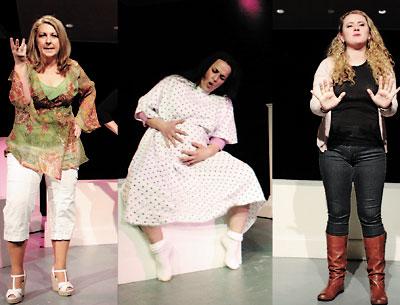‘Motherhood’ and Its Messy Parts

Life here on the South Fork differs from many similar areas across the country in several ways, one of the most important of which is the level of sophistication in the local art scene. This extends to the performing arts, including theater, even at the nonprofessional level, as is attested to by the Center Stage at Southampton Cultural Center’s current production of “Motherhood Out Loud,” a series of scenes examining modern motherhood in America, directed by the multitalented Michael Disher.
“Motherhood Out Loud” is no pastiche of pleasantries, or a Norman Rockwell Happy Mother’s Day card. Rather, it wrestles with the gritty realities of giving birth and raising children in the complex world we live in.
“Motherhood Out Loud” was first envisioned by two New York producers, Susan Rose and Joan Stein. Instead of entrusting the piece to one writer, they asked 14 to contribute short scenes, resulting in a 16-scene show by Leslie Ayvazian, Brooke Berman, David Cale, Jessica Goldberg, Beth Henley, Lameece Issaq, Claire LaZebnik, Lisa Loomer, Michele Lowe, Marco Pennette, Theresa Rebeck, Luanne Rice, Annie Weisman, and Cheryl L. West. In a sense, they are actually 16 short, short plays. (There are only 15 scenes in this production, but more on that later.) “Motherhood Out Loud” debuted at Hartford Stage in 2010, with a New York production at Primary Stages in 2011.
Most of the scenes are pithy. Many are in monologue form.
Under the astute direction of Mr. Disher, who also designed the set, his nine-player cast dives into the tricky material with gusto, giving us, for the most part, a smooth and moving production. Dan Becker, Valerie J. DiLorenzo, Adam Fronc, Barbara Jo Howard, Kasia Klimiuk, Joan Lyons, Josephine M. Teresi-Wallace, Edna Winston, and Susan Wojcik star.
Ms. Wojcik, in “Queen Esther” by Ms. Lowe, comes to terms with the reality that her 7-year-old son prefers high heels and dresses to a baseball uniform and cleats. He could be another Derek Jeter, she muses, “if Derek Jeter were to wear a black dress and pearls.”
It is funny, but also very serious, and timely, as her son returns home from school bloodied and with a black eye. Her courage in embracing her son, who is dressed as Queen Esther, in front of her temple’s congregation, moves us in the audience to a place where we as a society need to go.
In “Baby Bird” by Ms. Rebeck, the scene that follows “Queen Esther,” Ms. Teresi-Wallace plays a mother with a biological son, who has chosen to adopt a Chinese baby. Dan Becker heckles her with inane questions about her adopted daughter, such as, is she teaching the girl Chinese and did she go to China for the girl?
“She’s Chinese. Where else would we get her?” she responds.
In Mr. Pennete’s “If We’re Using a Surrogate, How Come I Am the One With Morning Sickness,” Mr. Fronc plays a neurotic (“I once had to see a therapist to break up with my therapist”) father-to-be, one half of a male couple waiting on a surrogate mother’s delivery of their baby. His initial plan is to take the baby away from the birth mother as soon as it is born. But when he sees the newborn (“It’s a gay-be!” he says) he hands her, instead, to the birth mother.
The first act finishes with Ms. Howard in Ms. LaZebnick’s “Michael’s Date,” in which Ms. Howard describes driving her autistic son to the movie theater for his first date with a girl. Things don’t go well, particularly in the car ride back to the girl’s house after the film. When the girl says she liked the leading lady, the son replies, “She sucked.”
Alone in the car, the mother momentarily lashes out at the son. It is a moving, truthful moment, finely handled here.
The second act picks up with the same energy and insight, looking at mothers as their children grow.
I didn’t feel drawn into the production until the hilarious fourth scene, “New in the Motherhood” by Ms. Loomer, in which Ms. Howard and Ms. Klimiuk exchange barbs by the sand box with Ms. DiLorenzo, a young mother with attitude.
Ms. DiLorenzo is a talented actor who finds the humor and pathos in her scenes without ever straining. She finishes the show in Ms. Weisman’s “My Baby,” a scene that completes the circle of motherhood, as she reflects on her newborn baby.
There are some rough spots in this production, particulary at the opening. “Fast Birth Fugue,” also by Ms. Lowe, has three mothers to be played Ms. Teresi-Wallace, Ms. Wojcik, and Joan Lyons, in hospital gowns, moments before giving birth, groaning and cursing.
The scene, as performed, did not work for me or for most of the audience at the Sunday matinee, and this was not your “blue-haired” matinee crowd from days of yore.
My companion suggested pacing, but it felt to me as if you could race through the scene like a thoroughbred and get nowhere fast.
In its original production, the play was done with a four-person cast, in 16 scenes. One scene has been omitted here, Lameece Issaq’s “Nooah’s List,” which, according to the “Motherhood Out Loud” Web site, focused on how an Arab-American mother deals with her daughter when she begins to menstruate.
The original New York four-person cast included an actress of color, who played the role of the mother in the missing scene. Despite the sophistication of the Hamptons, one thing seems to be missing from its theater community — color. It would be nice to see the faces on stage reflect the world I see around me, but, having said that, “Motherhood Out Loud” is a mostly enjoyable night at the theater.
The production runs through March 24, Thursday nights at 7:30, Friday and Saturday at 8 p.m., and Sundays at 2:30.
